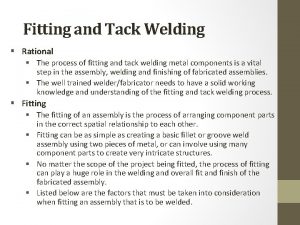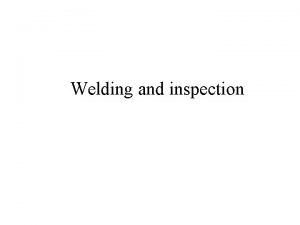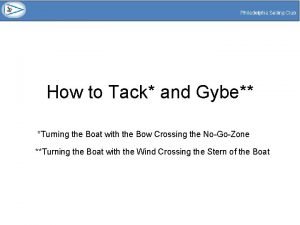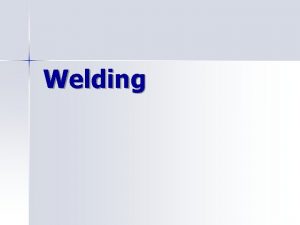Fitting and Tack Welding Rational The process of



- Slides: 3

Fitting and Tack Welding § Rational § The process of fitting and tack welding metal components is a vital step in the assembly, welding and finishing of fabricated assemblies. § The well trained welder/fabricator needs to have a solid working knowledge and understanding of the fitting and tack welding process. § Fitting § The fitting of an assembly is the process of arranging component parts in the correct spatial relationship to each other. § Fitting can be as simple as creating a basic fillet or groove weld assembly using two pieces of metal, or can involve using many component parts to create very intricate structures. § No matter the scope of the project being fitted, the process of fitting can play a huge role in the welding and overall fit and finish of the fabricated assembly. § Listed below are the factors that must be taken into consideration when fitting an assembly that is to be welded.

§ Linear and Angular Relationships § Linear and angular relationships describe how the component parts of a fabricated/welded structure are positioned in relationship to each other. § Linear and angular relationships are generally expressed using a dimension/spatial description and are communicated using a blueprint or welding procedure specification. § Root Opening § The root opening is the space between two pieces of metal that are used to create a butt or groove weld joint § The root opening is generally specified on a blueprint or welding procedure specification. § Offset describes the surface flatness of components that are arranged to create a flat surface. § Offset is often described using the term “flush” to describe the surface relationship of the two adjacent, flat components. § Where welding is concerned, The American Welding Society D 1. 1 Structural Steel Code limits the total amount of allowable offset of welded structures to 10% of the metal thickness up to 1/8” inch.

§ Tack Welding § The process of using small welds to tack or affix pieces of metal to one another before the final welding is performed. § Well executed tacks should fit the following criteria: § § § Large enough to keep the component parts in the correct spatial relationship to each other (Big enough to do the job) Small enough to be integrated into the body of the finished weld without being conspicuous (not obvious after welding) Spaced correctly. Tack welds should be spaced no more than twenty metal thicknesses apart and should not exceed on inch in length. § The process of fitting and tacking welded assemblies at a high level of quality is one that comes with developing an eye for detail and repetition. § In general terms, if the fitting and tack welding process is performed in a sloppy fashion, the process of finish welding and overall fit and finish of the welded assembly can be greatly affected.





